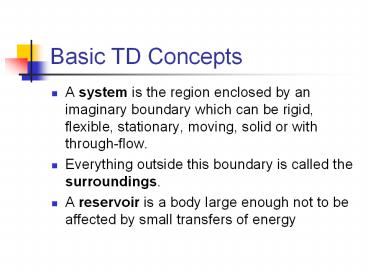Basic TD Concepts PowerPoint PPT Presentation
1 / 9
Title: Basic TD Concepts
1
Basic TD Concepts
- A system is the region enclosed by an imaginary
boundary which can be rigid, flexible,
stationary, moving, solid or with through-flow. - Everything outside this boundary is called the
surroundings. - A reservoir is a body large enough not to be
affected by small transfers of energy
2
Closed vs. Open System
- In a closed system no mass can cross the system
boundary. - In an open system mass can cross the system
boundary. - Energy without mass can cross the boundaries of
an open system. - If neither mass nor energy cross the boundary the
system is isolated.
3
Control Features
- A control surface surrounds a system or part of a
system. - The volume contained inside a control surface is
the control volume. - The mass contained inside a control surface is
the control mass.
4
Energy
- A macroscopic body can have
- Kinetic energy (1/2 m v2)
- Potential energy
- Gravity (mgh)
- Spring (1/2kx2)
- Electric/magnetic field
- Internal energy
5
Internal energy (U)
- The internal energy (hotness) of a body is due to
the following microscopic (molecular energies) - Translational (KE)
- Rotational (KE)
- Vibrational (KE PE)
- Electronic
- Molecular/chemical
- Nuclear
6
Total Energy its Transfer
- Internal energies depend on temperature U
fn(T) - Total energy KE PE U
- Energy can be transferred as
- Work - random molecular motion becomes organized
motion. W PdAdx PdV - Heat across a temperature gradient. Qkdt/dx
7
Thermodynamic Properties
- Thermodynamic properties are independent of
location, velocity or acceleration. - Intensive variables do not depend on system size
(p, T, ?, specific values). - Extensive variables depend on system size (m, V,
U). - Ratios of extensive variables are intensive.
8
Equilibrum
- A system reaches equilibrium when it will no
longer change even if we wait forever. - Thermal equilibrium T uniform (no heat
transfer). - Mechanical equilibrium p uniform (no work).
- Chemical equilibrium composition fixed.
- Thermodynamic equilibrium all of the above.
- State - a unique combination of all properties of
the system.
9
State variables
- State variables are variables that are fixed for
a given state. - For a given change in state they change by a
fixed amount. - Examples of state variables p, T, ?, V, u, s,
h, etc. - Not state variables (path dependent) are w, q.
- On a p-V or s-T diagram a state is a point.
- Path between two points is a process.

